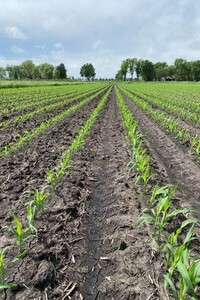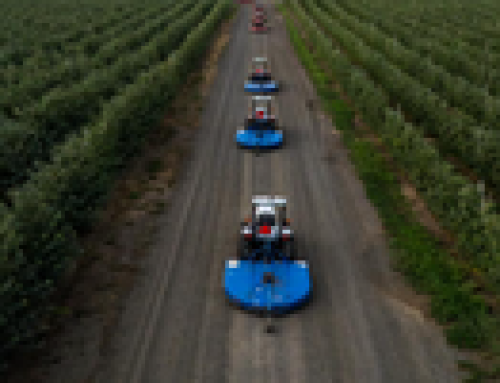Source: LG Seeds news release
 |
|---|
| The number of kernel rows per ear is determined around V6, making it one of the most influential growth stages for corn. |
WESTFIELD, Ind. — Considered one of the most influential growth stages in corn, V6 is a critical time to mitigate risk with timely management strategies.
“The number of kernel rows per ear is determined around V6, so any competition the corn plant has is adding stress on that crop that could diminish yield,” says Shane Irlbeck, LG Seeds agronomist. “It’s important to mitigate that as much as possible.”
Why is V6 important?
There are four key windows when corn yields are most influenced: VE, V6, V10-V12 and R5-R6. By V6, plant stands are established, rapid stem elongation begins and the number of kernel rows per ear is being determined. During this period, growers want the plant focused on building yield, not battling stress.
“Drought or crop stress at this time can impact the yield potential we’re setting up for the year,” says Irlbeck. “The crop’s ability to overcome V6 stressors depends in part on whether it flexes in ear length or girth or by kernel depth, but regular scouting and a fungicide application can help in either scenario.”
Scout and identify threats
The first step in maximizing the V6 period is knowing what challenges your corn crop is facing, so the more time you spend scouting in the field, the better. Irlbeck says if you’re seeing signs of stress at V6, the crop is feeling it too.
“If you see nutrient deficiencies, a foliar or a soil-applied rescue application can help, but keep in mind that some damage has already been done,” says Irlbeck. “It’s better to be out there, know you have an issue at the time and take action than wondering why it yielded poorly.”
Respond strategically and promptly
Corn faces multiple challenges during V6, so keeping the competition away from the plant is critical. With weed pressure, Irlbeck’s advice is to start clean and stay clean.
“Use a good preemergence herbicide, multiple modes of action and make sure you’re going early if you’re just using a postemergence application,” says Irlbeck.
Growers should scout for other common V6 pressures like corn rootworm by digging roots and floating larvae. While it’s not possible to control corn rootworm once feeding is underway, Irlbeck notes that prevention is key and “stacking protective traits can help mitigate risk, as can a soil-applied insecticide.”
In terms of disease management, Irlbeck shares that “fungicides are critical if you’ve had disease in the past, especially in a corn-on-corn situation.”
Address nutrient deficiencies
The V6 stage is also when nitrogen uptake begins, so growers should be on watch for nutrient deficiencies and be prepared to correct them.
“You may see some sulfur or nitrogen deficiency,” says Irlbeck. “If you have it in your program to do some side-dress nitrogen, V6 to V8 is an optimal time because it’s not long until we’re pushing tassels.” Since corn uses up to 70% of its nitrogen before R1,* having the appropriate amount of nitrogen applied ahead of tasseling is crucial.
“The rapid growth period from V7 to tassel is when most of the nitrogen in that plant is taken up and used,” Irlbeck explains. “Make sure you have enough fertilizer up front or split-applied.”
Signs of success
You may start to see suckers or tillers appear on the plant at V6. In most cases, it’s not something to worry about. “Tillered corn is happy corn,” says Irlbeck. “That typically means it has enough nutrients and moisture that it thinks it can throw another stalk out there.”
His final way to maximize this growth stage — a cross-check on your management plan. “Make sure you’re talking to your agronomist who’ll know how to anticipate how hybrids will react to different management practices and get the best bang for your buck.”
For help with crop management and mitigating risk this season, reach out to your local LG Seeds agronomist.
ABOUT LG SEEDS
LG Seeds is a dealer-driven national seed brand offering solid agronomic support, straightforward service and consistent plant performance that yields. LG Seeds’ portfolio of broad trait choices and tailored genetics brings corn, soybean, sorghum and alfalfa products to fit farmers’ performance goals. For more information visit LGSeeds.com and follow us on Facebook, Instagram, LinkedIn and X, formerly known as Twitter.
ABOUT AGRELIANT GENETICS
AgReliant Genetics is committed to providing trusted seed solutions that help farmers grow. We do this by focusing solely on seed and delivering one-of-a-kind, high-performing hybrids. Founded in 2000 by global seed companies KWS and Limagrain, AgReliant Genetics benefits from direct access to a global corn germplasm pool and has a top four corn research program. Through our seed brands, AgriGold® and LG Seeds in the U.S. and PRIDE® Seeds in Canada, we proudly offer the latest innovation to our farmer customers, whether they grow corn, soybeans, sorghum or alfalfa. Discover more at AgReliantGenetics.com.



